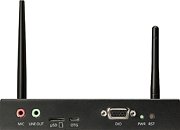Wednesday, November 15th 2017

VIA Announces VIA ARTiGO A630 Enterprise IoT Gateway System
VIA Technologies, Inc., today announced the launch of the VIA ARTiGO A630, an ultra-slim fanless gateway system with flexible customization options for a broad spectrum of commercial M2M and IoT applications. Featuring a high-performance 1.0GHz VIA Cortex-A9 dual-core SoC, multiple network connectivity options, and a rich combination of I/O, the VIA ARTiGO A630 adds a cost-effective solution to the growing range of VIA Enterprise IoT gateway devices designed to manage the connection and control for a wide spectrum of connected HMI and automation applications.
"The VIA ARTiGO A630 bolsters our already diverse range of ARTiGO Series M2M and IoT gateway systems," said Richard Brown, VP International Marketing, VIA Technologies, Inc. "Providing a rich mix of connectivity and performance in an ultra-compact design that can be rapidly customized, will help customers speed time-to-market and unlock the full potential of their IoT deployments."VIA ARTiGO A630 Enterprise IoT Gateway
Powered by a 1.0GHz VIA ARM Cortex-A9 dual-core SoC, the VIA ARTiGO A630 features a high-performance 2D/3D graphics and video engine that supports Open GL ES 2.0 hardware acceleration and comes with an on-board Micro SD card slot, 4GB eMMC Flash memory, and 1GB DDR3 SDRAM.
Measuring just 154.4mm x 27mm x 106.7mm (W x H x D), the VIA ARTiGO A630 offers a rich array of I/O and display expansion options, including one HDMI port, one RS-232/485 COM port, one DIO port with support for 8-bit GPIO, two USB 2.0 ports, one micro USB 2.0 port, one 10/100Mbps Ethernet port, and one miniPCIe slot. Optional Wi-Fi and 3G wireless modules are also available which can be supported through on-board USB pin-headers or the miniPCIe slot.
The ARTiGO A630 features an optimized Linux BSP (Kernel 3.4.5) supporting all key onboard hardware features to speed development, deployment and ease system management. A full set of software customization services that speed up time to market and minimize development costs is also available.
For more information about the VIA ARTiGO A630, please visit this page.
"The VIA ARTiGO A630 bolsters our already diverse range of ARTiGO Series M2M and IoT gateway systems," said Richard Brown, VP International Marketing, VIA Technologies, Inc. "Providing a rich mix of connectivity and performance in an ultra-compact design that can be rapidly customized, will help customers speed time-to-market and unlock the full potential of their IoT deployments."VIA ARTiGO A630 Enterprise IoT Gateway
Powered by a 1.0GHz VIA ARM Cortex-A9 dual-core SoC, the VIA ARTiGO A630 features a high-performance 2D/3D graphics and video engine that supports Open GL ES 2.0 hardware acceleration and comes with an on-board Micro SD card slot, 4GB eMMC Flash memory, and 1GB DDR3 SDRAM.
Measuring just 154.4mm x 27mm x 106.7mm (W x H x D), the VIA ARTiGO A630 offers a rich array of I/O and display expansion options, including one HDMI port, one RS-232/485 COM port, one DIO port with support for 8-bit GPIO, two USB 2.0 ports, one micro USB 2.0 port, one 10/100Mbps Ethernet port, and one miniPCIe slot. Optional Wi-Fi and 3G wireless modules are also available which can be supported through on-board USB pin-headers or the miniPCIe slot.
The ARTiGO A630 features an optimized Linux BSP (Kernel 3.4.5) supporting all key onboard hardware features to speed development, deployment and ease system management. A full set of software customization services that speed up time to market and minimize development costs is also available.
For more information about the VIA ARTiGO A630, please visit this page.



1 Comment on VIA Announces VIA ARTiGO A630 Enterprise IoT Gateway System
What I like about this one, is an 8-bit GPIO port on the front panel. Even though it's an underpowered device, that one aspect still makes it slightly better than competition.
SoC sucks, though... it's an equivalent of Allwinner A20, which is not impressive and definitely not enough for smooth media playback in 1080p (even if you manage to get an old MALI driver running on 3.xx kernel or above).
Also, no GbE and no SATA... :kookoo:
Basically a shrunk-down Cubieboard 2 in a nice enclosure.